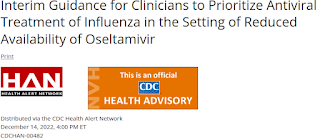#17,172
Just over a month ago, in CDC FluView Week 44: Flu Still Rising Sharply, I mentioned early reports that the influenza antiviral oseltamivir (aka `Tamiflu') was reportedly in short supply in some parts of the country, and since then the flu - and shortages - have grown much worse.
And it isn't just Tamiflu. Everything `cold & flu related' is flying off the pharmacy shelves.
Over-the-Counter (OTC) medications like cough drops, and children's Tylenol, are in just as short supply as prescription medications like oseltamivir, Albuterol inhalers, and the common antibiotic amoxicillin, among many others (see FDA list).
With the winter respiratory season likely to extend for many more weeks, these shortages are forcing doctors to decide how best to use the limited supply available. Overnight, the CDC published a HAN (Health Alert Network) Advisory with guidance for clinicians.
The CDC uses their HAN (Health Advisory Network) to provide up-to-date information to a wide audience of health care professionals, including public information officers; federal, state, territorial, tribal, and local public health practitioners; clinicians; and public health laboratories.
While geared for clinicians, others may find this information useful. Due to its length, I've only published the summary, background information, and general recommendations. Follow the link to read it in its entirety.
Interim Guidance for Clinicians to Prioritize Antiviral Treatment of Influenza in the Setting of Reduced Availability of Oseltamivir
Distributed via the CDC Health Alert Network
December 14, 2022, 4:00 PM ET
CDCHAN-00482
Summary
Seasonal influenza activity is high across the United States. The Centers for Disease Control and Prevention (CDC) estimates that in the 2022-2023 season to date, there have been at least 13 million illnesses, 120,000 hospitalizations, and 7,300 deaths from influenza (Weekly U.S. Influenza Surveillance Report | CDC). While the Food and Drug Administration (FDA) has not indicated shortages of oseltamivir (generic or Tamiflu) in any of its forms (capsules, oral suspension), CDC has received numerous anecdotal reports of availability issues for generic oseltamivir in some locations [1]. This may continue to occur in some communities as influenza activity continues.
This Health Alert Network (HAN) Health Advisory provides clinicians and public health officials with guidance for prioritizing oseltamivir for treatment and information on other influenza antivirals that are recommended for treating influenza in areas where oseltamivir is temporarily unavailable.
Background
Antiviral treatment of influenza is an important adjunct to influenza vaccination in the prevention and control of influenza and, when given early, reduces the duration of symptoms and may reduce the risk of some complications [2-4]. Influenza viruses typically circulate annually in the United States, most commonly from the late fall through the early spring. Most people recover from influenza without serious complications or sequelae. However, influenza can be associated with serious illnesses, hospitalizations, and deaths, particularly among people at increased risk of complications such as older adults, very young children, pregnant people, and people of all ages with certain chronic medical conditions [2].
Four FDA approved prescription antiviral medications (oseltamivir, baloxavir, zanamivir, and peramivir) are available for use for early treatment of outpatients with influenza. These antivirals have different formulations, routes of administration, dosing, duration of treatment, and recommendations for administration by age group. The clinical benefit of antiviral treatment of influenza is greatest when treatment is started early (within 2 days of illness onset) in people with mild, uncomplicated illness [3-4]. Oseltamivir treatment also is recommended as soon as possible for suspected or confirmed influenza requiring hospitalization, and to help control institutional influenza outbreaks [4].
A wide range of tests for respiratory specimens are available in clinical settings for diagnosing influenza. Use of influenza testing, particularly rapid molecular assays, can inform antiviral treatment decisions, especially when other respiratory viruses are co-circulating in the community. CDC has testing guidance for clinicians when SARS-CoV-2 and influenza viruses are co-circulating. Of note, because SARS-CoV-2 and influenza virus co-infection can occur, a positive influenza test result without SARS-CoV-2 testing does not exclude COVID-19, and a positive SARS-CoV-2 test result without influenza testing does not exclude influenza.
CDC recommends annual influenza vaccination of people aged 6 months and older as the first and most important tool to prevent influenza [2]. For people aged 65 years and older, high-dose, recombinant, or adjuvanted influenza vaccines are recommended if available [2]. Healthcare providers should strongly encourage people who have not yet received influenza vaccination this season to get vaccinated as they can still benefit.
General Recommendations for Clinicians and Public Health Practitioners
Available information suggests that current local antiviral availability issues are due to limited availability of generic oseltamivir, specifically [1].If available, brand-name oseltamivir (Tamiflu) can be used to treat outpatients and hospitalized patients with influenza.
If oseltamivir is unavailable, oral baloxavir, inhaled zanamivir, or intravenous peramivir can be used for early treatment of outpatients at increased risk for complications who present with uncomplicated influenza, depending upon age and contraindications.
When there is limited availability of oseltamivir or other antivirals, antiviral treatment should target patients with influenza who are at the highest risk of severe disease and those who are hospitalized.
Antiviral treatment of outpatients should be prioritized for persons who test positive for influenza within 2 days of illness onset.
When there is limited availability of oseltamivir or other antivirals, patients with clinically mild influenza who are otherwise healthy and not at increased risk of influenza complications can be managed with supportive care without antiviral treatment.
(Continue . . . )
Getting vaccinated (or boosted) against influenza, COVID, and pneumonia can prevent or lessen the severity of one's illness, and wearing a mask in public can provide even more protection.
We'll get the latest FluView numbers tomorrow, and while last week showed a slight dip, we probably have many weeks to go before this year's respiratory season subsides.
